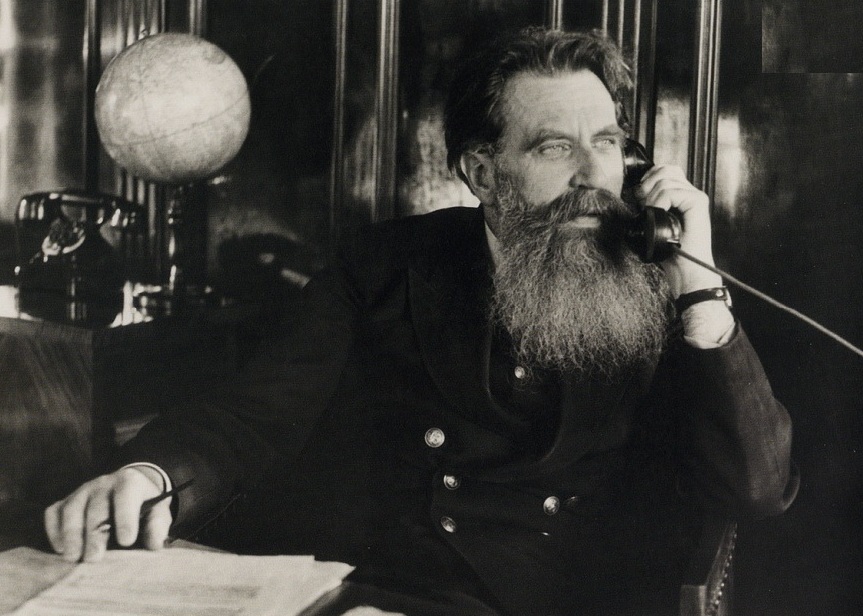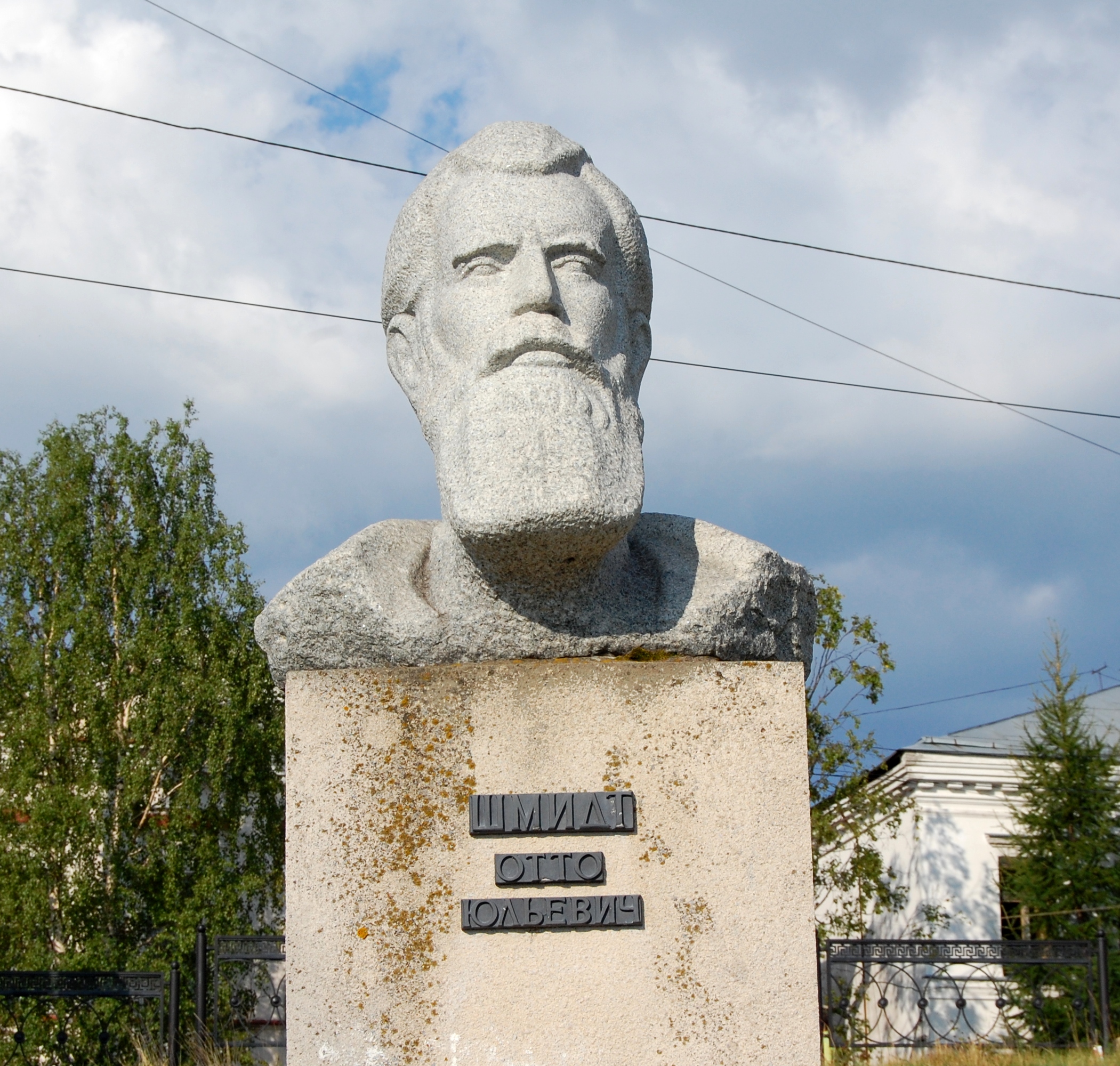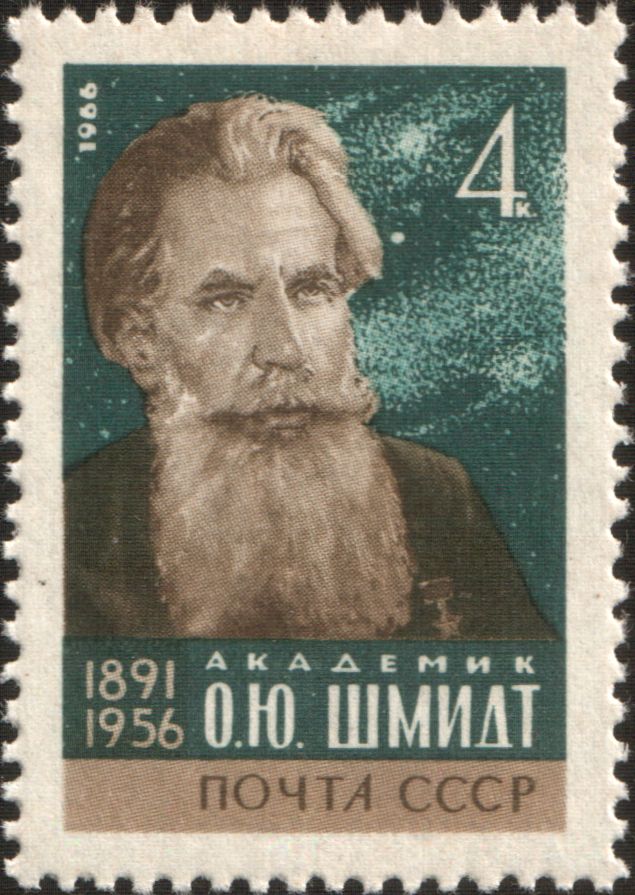1. Biography
Otto Yulyevich Schmidt's life was marked by significant contributions across science, exploration, and public service within the Soviet Union, reflecting his diverse talents and leadership capabilities.
1.1. Early Life and Origins
Schmidt was born on September 30, 1891, in the town of Mogilev in the Russian Empire, a region that is now part of Belarus. His family background reflected the multi-ethnic composition of the Russian Empire; his father was a descendant of German settlers who had settled in Courland, while his mother was of Latvian descent.
1.2. Education
Schmidt's formal education began with his graduation from a high school in Kiev in 1909. He then pursued higher studies at Kiev University, where he focused on physics and mathematics. He graduated from the university in 1913. Following his graduation, he continued his academic career at Kiev University, working as a privat-docent starting from 1916. He later became a professor at the Second Moscow State University and subsequently at Moscow State University, where he continued to teach until 1956. From 1930 to 1932, he also served as the head of the Arctic Institute.

1.3. Political Affiliation and Early Career
Schmidt's involvement in politics began with his membership in the Russian Social Democratic Labour Party (Internationalists) in 1918. This party was later integrated into the Russian Communist Party, making Schmidt a member of the Communist Party of the Soviet Union.
Following the October Revolution of 1917, Schmidt rapidly ascended to influential positions within various Soviet government bodies, known as People's Commissariats (Narkomats). From 1918 to 1920, he served as a board member at Narkomprod (the People's Commissariat for Supplies). He then transitioned to the People's Commissariat for Finance (Narodnyi Komissariat Finansov), where he was a board member from 1921 to 1922. Additionally, he held a position at the People's Commissariat for Education (Narkompros) from 1919 to 1932.

Schmidt was a significant advocate for the development of higher education, publishing, and scientific research in Soviet Russia. He worked at the State Scientific Board under the Council of People's Commissars of the USSR and was also involved with the Communist Academy. In October 1921, he was appointed Chair of the Foreign Literature Committee. Between 1921 and 1924, he served as the director of the State Publishing House (Gosizdat). His most notable publishing role was as the chief editor of the Great Soviet Encyclopedia, a position he held from 1924 to 1941.
2. Major Activities and Achievements
Otto Schmidt's career was marked by groundbreaking contributions in diverse fields, particularly in science, academic institution building, and Arctic exploration.
2.1. Scientific and Academic Contributions
In the field of mathematics, Schmidt made early and foundational contributions to group theory. His work in 1912-1913, while still a university student, laid the groundwork for the development of the Krull-Schmidt theorem. He was also a founder and long-time director of the Moscow Algebra School, a significant academic institution for algebraic research.
In geophysics, Schmidt organized the Institute of Theoretical Geophysics within the Soviet Academy of Sciences, serving as its director until 1949. This institute became a key center for geophysical research.
His interests extended to astronomy and cosmogony. In the mid-1940s, Schmidt proposed a groundbreaking new cosmogonical hypothesis concerning the formation of the Earth and other planets within the Solar System. He continued to develop this hypothesis with a group of Soviet scientists until his death.
Beyond his direct research, Schmidt played a crucial role in the organization and dissemination of scientific knowledge. As the chief editor of the Great Soviet Encyclopedia from 1924 to 1941 (or 1926-1941 according to some sources), he oversaw the creation of a monumental work that synthesized knowledge across various disciplines. He is also credited with coining the term for the double bond rule, a concept primarily relevant in chemistry.
2.2. Arctic Exploration and Leadership
Schmidt was a renowned explorer of the Arctic and a leading figure in the Soviet Union's efforts to master the Northern Sea Route. From 1932 to 1939, he was appointed head of Glavsevmorput' (Glavnoe upravlenie Severnogo Morskogo Puti), an organization responsible for overseeing all commercial and scientific operations along the Northern Sea Route.
He led several pivotal Arctic expeditions:
- In 1929 and 1930, he commanded expeditions on the steam icebreaker Georgy Sedov. During these voyages, he established the first scientific research station on Franz Josef Land, explored the northwestern parts of the Kara Sea and the western coasts of Severnaya Zemlya, and discovered several new islands.
- In 1932, Schmidt's expedition on the steam icebreaker Sibiryakov, under the command of Captain Vladimir Voronin, achieved a historic feat: a non-stop voyage from Arkhangelsk to the Pacific Ocean without wintering. This marked the first time in history that such a journey was completed.
- From 1933 to 1934, Schmidt again led a voyage along the Northern Sea Route, this time on the steamship Cheliuskin, also with Captain Vladimir Voronin.
- In 1937, he supervised an airborne expedition that successfully established the "North Pole-1" drift-ice station, the world's first manned drifting research station. In 1938, he was personally in charge of the challenging operation to evacuate the station's personnel from the drifting ice.

2.3. Political and Administrative Roles
Beyond his scientific and exploration endeavors, Otto Schmidt held significant political and administrative positions within the Soviet government. He was a member of the Central Executive Committee of the USSR, a key governing body. He also served as a deputy of the Supreme Soviet of the USSR during its first convocation, holding this position from 1938 to 1946. From 1939 to 1942, Schmidt served as a vice-president of the Soviet Academy of Sciences, where he played an instrumental role in shaping the direction of Soviet science.
3. Ideology and Philosophy
As a member of the Communist Party of the Soviet Union, Otto Schmidt's core ideas, values, and belief systems were deeply intertwined with the prevailing Soviet ideology. He contributed significantly to the scientific and educational infrastructure of the Soviet system, believing in the power of organized science and education to advance societal progress. His work in developing higher education, publishing, and scientific research aimed to serve the goals of the Soviet state. His leadership in Arctic exploration was also closely aligned with the Soviet Union's strategic and economic ambitions to master the northern territories and sea routes.
4. Personal Life
In 1913, Otto Schmidt married Vera Yanitskaia, a psychoanalyst.
5. Death
Otto Yulyevich Schmidt died on September 7, 1956. He was buried in Novodevichy Cemetery in Moscow.
6. Legacy
Otto Schmidt's legacy is immense, spanning across the fields of science, exploration, and education. He is widely recognized for his pioneering work and lasting contributions to Soviet and global scientific endeavors.
6.1. Honours and Awards
For his extensive contributions and achievements, Otto Schmidt was awarded numerous high honours by the Soviet authorities. These include:
- Hero of the Soviet Union, bestowed on June 27, 1937.
- Order of Lenin, three times.
- Order of the Red Banner of Labour, twice.
- Order of the Red Star.
- He also received many other medals.

6.2. General Assessment
Otto Schmidt is generally assessed as a brilliant and versatile scientist, a visionary explorer, and an an effective administrator. His contributions significantly advanced mathematics, geophysics, and cosmogony. His leadership in Arctic exploration opened up the Northern Sea Route for navigation and scientific research, laying the groundwork for further development in the region. His efforts in establishing academic institutions, such as the Institute of Theoretical Geophysics and the Moscow Algebra School, and his role as chief editor of the Great Soviet Encyclopedia, underscore his commitment to fostering scientific development and education within the Soviet Union. His multifaceted career left an indelible mark on Soviet science and exploration.
7. Impact
Schmidt's work had a profound impact on several fields. His efforts in developing the higher education system and publishing were crucial for the intellectual growth of Soviet Russia. As chief editor of the Great Soviet Encyclopedia, he facilitated the standardization and dissemination of knowledge across the USSR. His establishment of the Institute of Theoretical Geophysics significantly bolstered Soviet research capabilities in geophysics.
His leadership of Glavsevmorput' and his personal participation in daring expeditions profoundly shaped the development and utilization of the Northern Sea Route. These efforts made the route navigable and facilitated scientific research in the Arctic, opening up new possibilities for trade and resource extraction in the region. The successful, non-stop voyage of the Sibiryakov and the establishment of the "North Pole-1" drifting station were milestones in polar exploration, demonstrating the Soviet Union's capabilities in extreme environments. Schmidt's cosmogonical hypothesis continued to influence planetary science research in the Soviet Union until his death.

8. Commemoration
Otto Schmidt is remembered and honoured through various dedications, reflecting the lasting impact of his contributions.
8.1. Named Places and Institutions
Numerous geographical features, institutions, and even a celestial body have been named in his honour:
- Schmidt Island in the Kara Sea.
- Cape Schmidt on the coastline of the Chukchi Sea in Chukotka Autonomous Okrug.
- The Institute of Earth Physics at the Soviet Academy of Sciences, which he helped organize.
- A minor planet, 2108 Otto Schmidt, discovered in 1948 by Soviet astronomer Pelageya Shajn, commemorates him.
- The Soviet research vessel Otto Schmidt was named after him in 1979.
- A bust of Otto Schmidt stands in Arkhangelsk, a city with strong ties to Arctic exploration.
- A Soviet stamp dedicated to Otto Schmidt was issued in 1966.